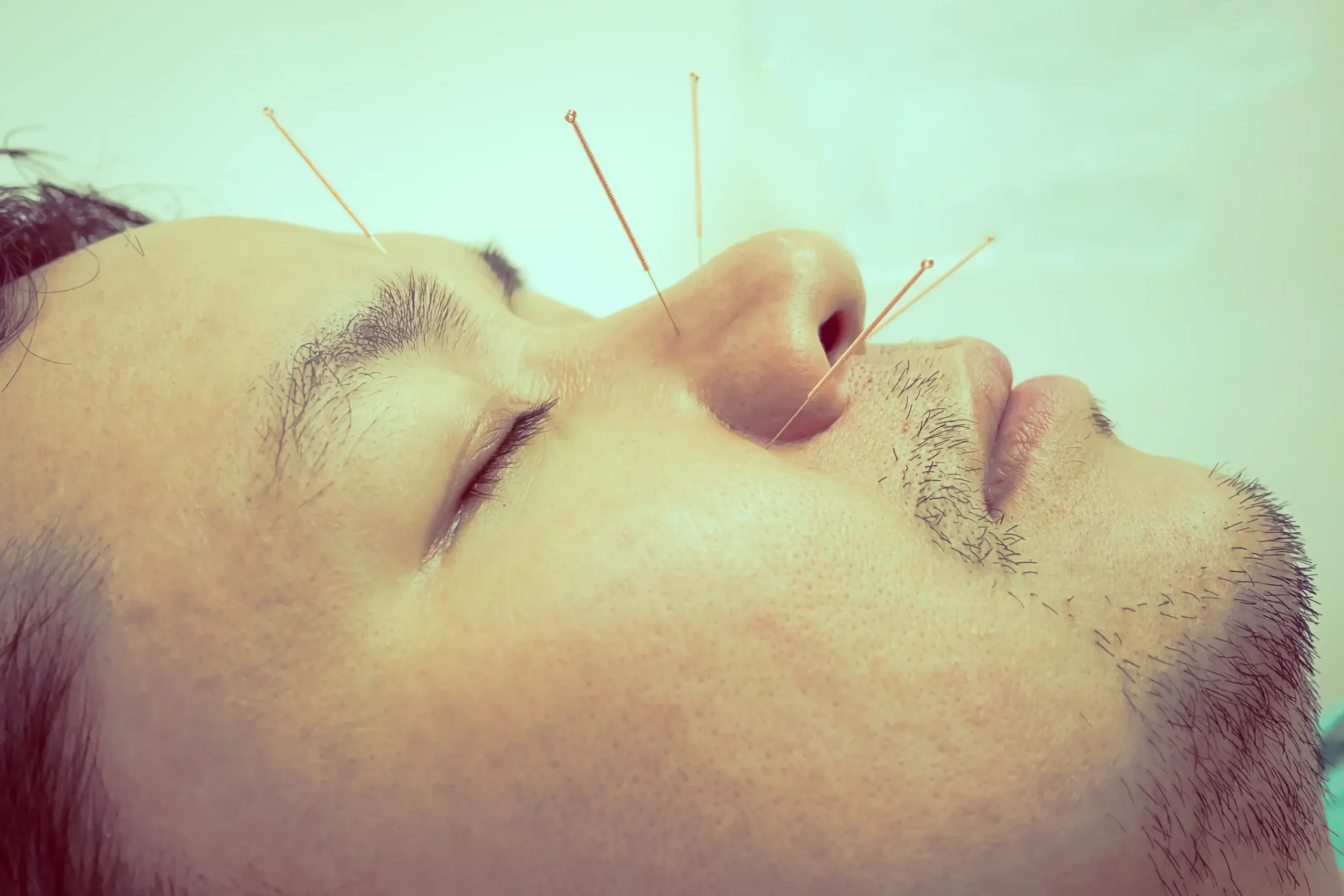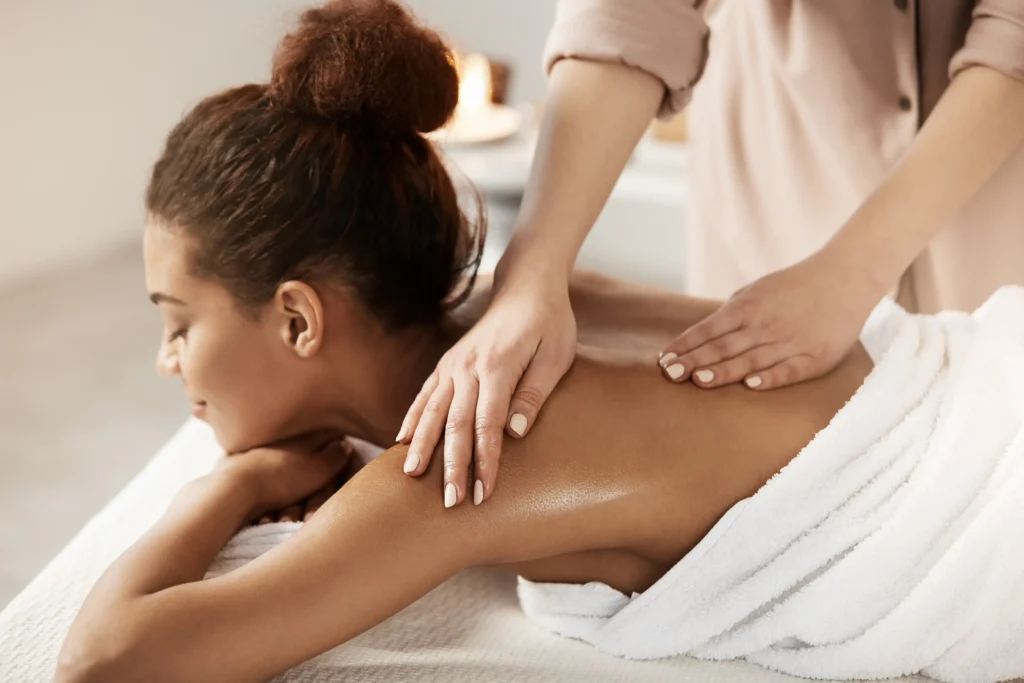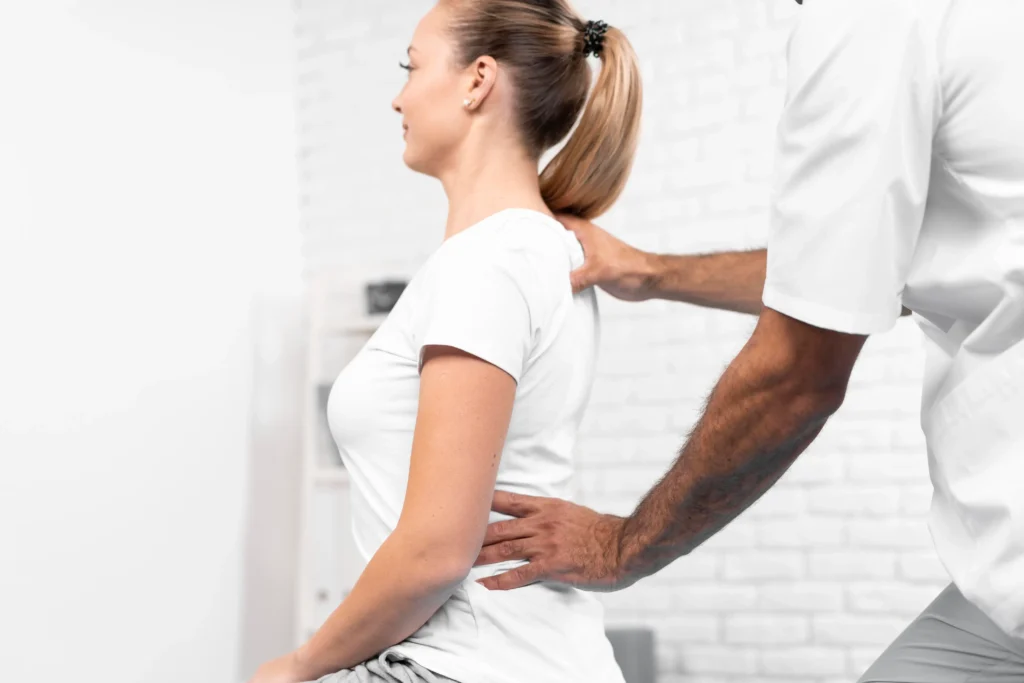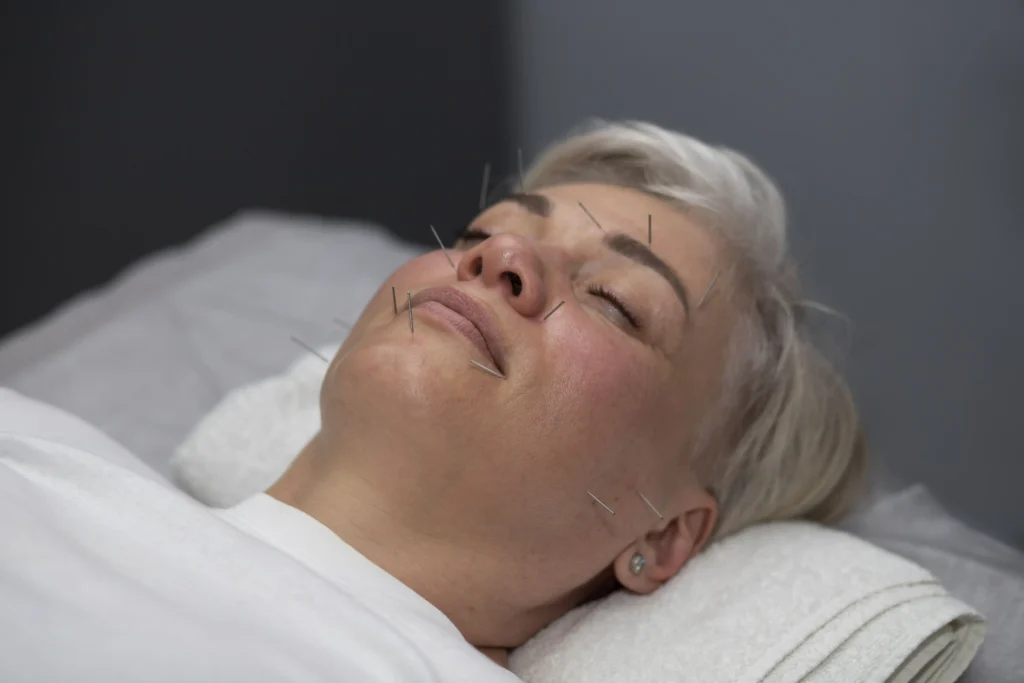Acupuncture uses fine needles for nervous system balance, while dry needling targets muscle tension and pain.
What is acupuncture?
Acupuncture uses inserting very fine needles into specific points on the body to influence how the nervous system responds. Modern approaches to acupuncture focus on its impact on the brain, spinal cord, and nerve pathways.
By stimulating certain points, acupuncture can activate sensory nerves, which then send signals to the central nervous system. This can prompt the release of natural pain-easing chemicals like endorphins, reduce inflammation, and help regulate autonomic functions like blood pressure, heart rate, and digestion.
Simply put, acupuncture helps “reset” the nervous system when it’s out of balance, helping the body to shift back into a more regulated, calm state. That’s why it’s commonly used for pain management, anxiety, migraines, and neurological issues.
What Are the Benefits of Acupuncture?
- Chronic Back Pain Relief. Acupuncture for lower back pain may be used to ease persistent lower or upper back pain without relying on medication.
- Support for Fibromyalgia. Regular sessions may help lower the widespread pain and fatigue associated with this condition.
- Headache and Migraine Help. Acupuncture can help with migraines and tension headaches. Sometimes, acupuncture for neck pain may be used, since headaches may come from neck issues.
- Menstrual and Labor Pain Reduction. Acupuncture benefits may help regulate menstrual cycles and ease cramps or discomfort during labor.
- Neck and Shoulder Pain Relief. This type of pain is common for people with desk jobs or postural issues. Acupuncture can help with stiffness and help you move easier.
- Help for Osteoarthritis. Some people with arthritis find acupuncture helpful in reducing inflammation and stiffness.
- Respiratory Relief. Benefits of acupuncture are also used to manage symptoms of conditions like allergic rhinitis or seasonal allergies.
- Better Sleep. Acupuncture for insomnia may help calm the nervous system and help you relax, which is useful for sleep quality.
- Stress and Anxiety Relief. By helping with relaxation and balancing the nervous system, acupuncture can support mental health.
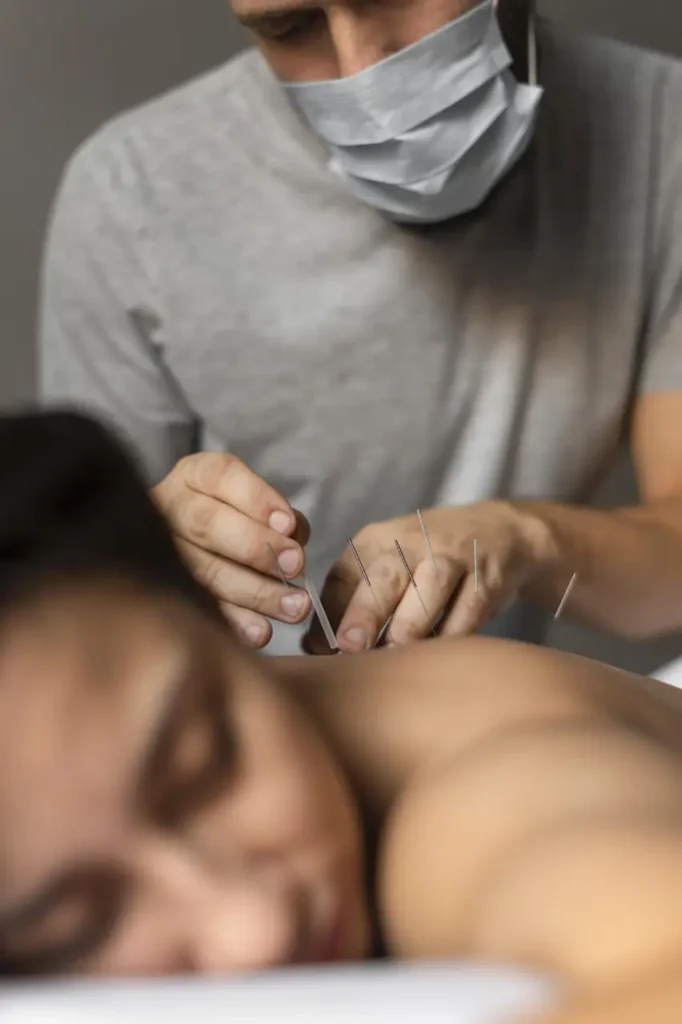
Acupuncture Side Effects
- Mild discomfort or bruising. It’s fairly common to feel a bit of soreness or notice a small bruise where the needle was inserted. This usually fades quickly.
- Light bleeding. A tiny drop of blood can sometimes appear at the needle site, especially in sensitive areas or if you bruise easily.
- Fatigue or lightheadedness. Some people feel tired, dizzy, or spacey after a session, especially if they haven’t eaten beforehand or are sensitive to physical therapies.
- Risk for those with certain health conditions. If you’re on blood thinners, have a bleeding disorder, are pregnant, or have a pacemaker, acupuncture might require extra caution. It’s important to talk to your healthcare provider first.
Infection risk from unclean needles. This is extremely rare with licensed professionals, but if needles aren’t sterile, there’s a risk of infection. Always go to a qualified acupuncturist to avoid such mistakes.
What Is Dry Needling?
Dry needling is a modern technique used to ease muscle tension, help with movement, and reduce pain. Unlike acupuncture, which comes from traditional Chinese medicine, dry needling is based on Western anatomy and is commonly used by physical therapists and sports injury specialists.
The process includes inserting very thin, solid needles, which are called monofilament needles, into trigger points or tight bands of muscle. Needles placements help ease tension, increase blood flow, and stimulate healing in a specific area of the body.
Dry needling targets muscles, tendons, and connective tissue, and is often used for conditions like muscle spasms, joint pain, or restricted movement. It’s regulated differently across U.S. states, with varying training and certification requirements depending on the location. In some areas, practitioners must complete special courses and get board approval before offering the treatment.
What Are the Benefits of Dry Needling?
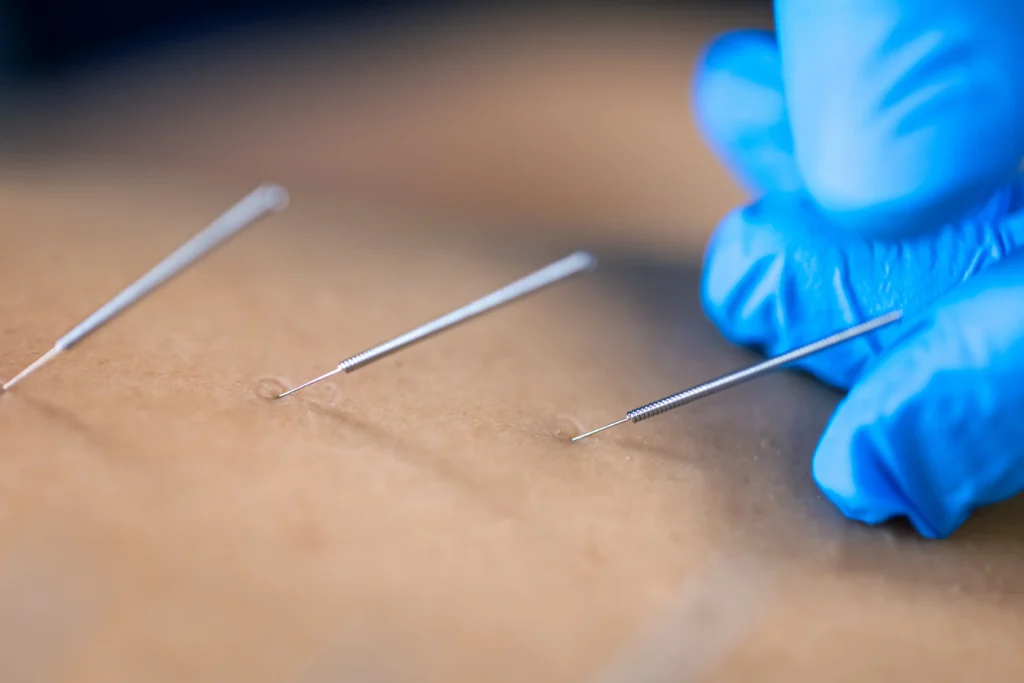
One of the biggest dry needling benefits is that it’s commonly used to release muscle knots (aka trigger points) that can cause pain in the neck, shoulders, or back. By targeting these specific areas, benefits of dry needling can help you move easier and with less tension.
It’s often recommended for people with sports injuries, tendon issues like tendinitis, or inflammation caused by conditions like bursitis. Dry needling is also used to manage pain from fibromyalgia and other neuromuscular disorders.
Another benefit is how well it works alongside physical therapy. It can help relax the muscles so patients can perform rehab exercises more comfortably. Dry needling alone may offer some relief, but pairing it with proper exercises is even better.
Dry Needling Side Effects
Dry needling is generally safe, but it does come with a few mild side effects. The most common reactions include minor bleeding, slight bruising, and muscle soreness that can last up to two days, pretty much like with acupuncture. These effects are temporary and usually manageable with rest or ice.
When performed near sensitive areas, like around the lungs, there’s a small risk of more serious complications like pneumothorax (collapsed lung). For this reason, trained professionals must always handle treatment.
Dry needling is not recommended for everyone. People who are pregnant may need to avoid it due to the small possibility of triggering early contractions. Likewise, those with immune systems issues, infections, or certain medical conditions like active cancer should speak with their provider before trying it, as healing responses might differ.
Since dry needling is still relatively new in many places, insurance often doesn’t cover it, and the availability of trained practitioners may vary depending on state regulations.
Additional Differences Between Dry Needling and Acupuncture
Types of needles
Both dry needling vs acupuncture use very thin, stainless steel needles – but they aren’t exactly the same. Acupuncture needles are usually finer and more flexible, while dry needling needles can sometimes be slightly thicker and firmer. There’s no strict universal standard, though, and each practitioner may have their own preferences when it comes to dry needling vs acupuncture.
Number of needles used
Acupuncture usually uses several needles placed at various points across the body – sometimes up to a dozen or more. Dry needling, on the other hand, usually requires far fewer – usually just two or three. It depends on your specific pain area and the provider’s technique. Some professionals at a wellness center Chicago may combine both approaches.
Length of a session
Dry needling sessions are often quicker than acupuncture treatments. Acupuncture needles might stay in place for 15-20 minutes, dry needling is usually more of a short burst – just enough to activate the muscle or trigger point and get results fast. It’s usually done alongside other treatments like massage, stretching, or physical therapy.
FAQs
Does Dry Needling Hurt?
Is Dry Needling the Same as Acupuncture?
Is Dry Needling Safe?
What Is Dry Needling vs Acupuncture?
Dry needling and acupuncture both use thin needles, but they differ in purpose and technique. Dry needling targets specific muscle trigger points to alleviate pain and muscle tension, primarily for musculoskeletal issues. Acupuncture, based on traditional Chinese medicine, aims to balance the body’s energy flow (Qi) and treats a wide range of conditions, including pain, stress, and digestive issues.
Author
-
Dr. Stephanie Madden is the founder of Copper Wellness, an integrative wellness clinic dedicated to holistic healing. A licensed acupuncturist, board-certified herbalist, and integrative medicine specialist, she specializes in complex cases, emotional trauma, and fertility. With a doctorate from AOMA and a passion for innovation, Dr. Madden blends expertise and compassion to empower patients on their wellness journey, creating a space where healing and transformation thrive.
View all posts
